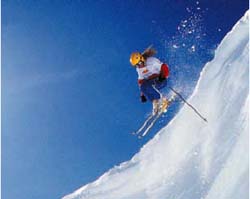
Tune Your Planks
Why tuning your skis is necessary for a kick-ass day on the mountain...

|
|
| Get those skis tuned... Courtesy of P. Media |
|
Owning a pair of skis is like owning a car...without regular servicing, performance and handling will decline along with its life. Keeping your skis in good running order is a lot more complex than just sharpening the edges and slapping on a bit of wax. Wax is like engine oil. The wax protects the metal ski edges from rusting and the ski bases from minor scratches and abrasions. Waxing also allows the ski to glide and turn better on the snow. Skis need re-waxing after every four days skiing or more often in dry powder conditions.
Having correctly sharpened and beveled edges as well as true ski bases is critical for keeping your skis predictable and easy to turn. If you cut your edges at 90 degree they will be very prone to grabbing and hooking into any little rut or bump in the snow. By adding a one-degree base edge bevel the ski won't bite until edge pressure is applied by the skier. Snow is incredibly abrasive and can dull your edges in as little as two days.
As well as dulling the edges the snow will gradually wear away the ski bases leaving the ski with either a concave or convex shape. This will make the ski difficult to turn, make the ski unpredictable and reduce edge hold.
When you bring your skis into a service center the staff will be able to examine the ski and recommend which method of tuning will be best suited to your skis. The two common tuning options are a 'quick tune' or a 'full crystal glide'.
The crystal glide process returns the ski base to show room condition.
"Having a properly tuned pair of skis can make all the difference between a pleasurable skiing experience and an
extremely frustrating day on the mountain. " |
The first step in the crystal glide process is to use a stone grinder to grind the ski base true. After the initial grinding is completed base repairs can be done.
To fill any small gouges in the ski base the gouge is chiseled out to a regular shape and the surfaces roughened with sandpaper. The repair area will then be cleaned with acetone to remove any grease or dirt. The gouge can then be filled using a P-tex extruder gun, which injects molten P-tex into the repair. After the repair has cooled, any excess material can be ground off. It is critical to fill any gouges that have gone right through the ski base to keep water out of the ski internals. If water gets into the ski it can lead to delaminating, which is costly to fix. Major base damage may need patching. To patch a ski the damaged area is cut away and a new piece of base material is cut to the shape of the hole. A flexible epoxy resin is applied, and then a heat plate is clamped over the patch to cure the resin.
The next step in the crystal glide process is to put a one-degree base edge bevel onto the ski using a belt-grinding machine fitted with a tuning belt.
From here the ski goes back to the stone grinder for structuring. The desired base structure pattern is cut into the stone using a diamond-dressing unit. The structuring process helps the ski to glide better on the snow by causing any water to bead on the base reducing friction. During the middle of winter when snow is cold and dry, a fine structure will be used. During spring the structure will be changed to a courser pattern for the wetter snow conditions.
After the structuring process the ski is ready to have its side edges sharpened. The edging machine will cut the edges at 90 degrees
to the ski base.
The ski tips and tails can then be de-tuned using a had file and then be de-burred using the belt grinder fitted with a de-burring belt. This stops the ski from grabbing too aggressively when a turn is initiated.
The next step is to hot wax the skis, scrape off any excess wax and then polish the wax using a polishing belt on the grinder.
A quick tune bevels the base edges, sharpens the side edges, then the ski is de-tuned, de-burred, waxed and polished.
It is possible to do some tuning work yourself. The important tools in your kit should be, wax, iron and scraper. A diamond stone for
removing edge case hardening, a multi angle edging tool, deburing block and a hand file. A true bar is handy for determining when you
need a crystal glide. Having a properly tuned pair of skis can make all the difference between a pleasurable skiing experience and an
extremely frustrating day on the mountain.

